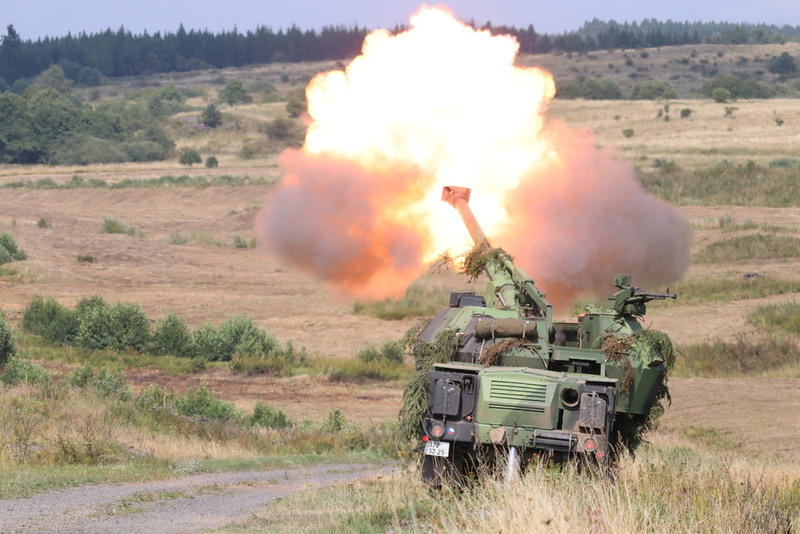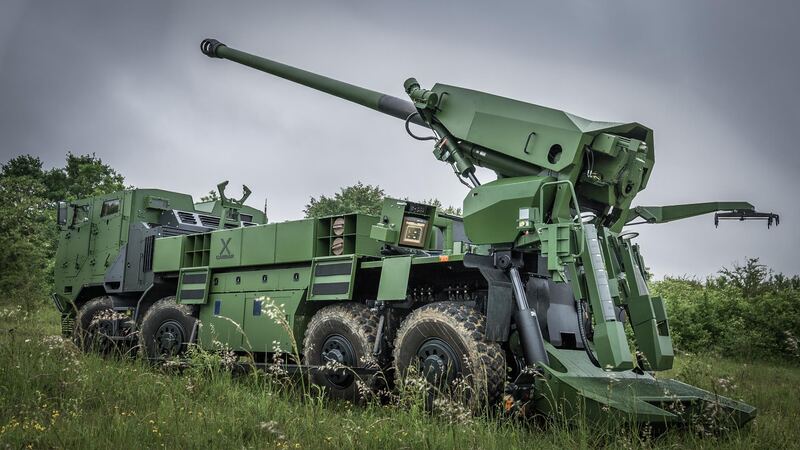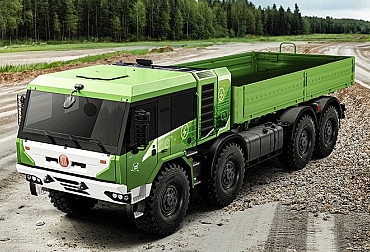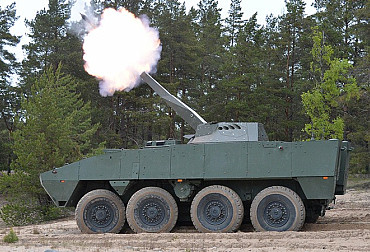New DITA self-propelled cannon howitzer
The recent introduction of the new Czech DITA self-propelled howitzer is one of the biggest surprises of the Czech defense industry in recent years. It is another expression of how the Czech defense industry is renewing and further strengthening its capabilities. At the same time, however, the artillery system raises a number of questions, more of a deeper, conceptual nature.
.jpg) Picture: DITA 155 mm wheeled cannon howitzer | EXCALIBUR ARMY / CC BY-NC-ND
Picture: DITA 155 mm wheeled cannon howitzer | EXCALIBUR ARMY / CC BY-NC-ND
From a purely technical point of view, the DITA howitzer is undoubtedly very interesting. Perhaps the most interesting thing about it is that it fully follows the construction line of the Czech, resp. Czechoslovak self-propelled howitzers, begun in the seventies of the last century with the legendary type 77 DANA. It can be recalled that the development of Czech, resp. Czechoslovak self-propelled howitzers was relatively complex. ShKH vz. 77 DANA caliber 152 mm was undoubtedly of a very high quality, to some extent a breakthrough design, and was therefore produced in large series for both the domestic army and for export. As early as the mid-1980s, however, it turned out that the performance of DANA howitzers was no longer sufficient for modern combat. The relatively low range, amounting to only 20.5 km, was not particularly suitable. Therefore, the then Czechoslovak defense industry designed a significantly modernized ONDAVA system, which retained the technical concept of the DANA self-propelled howitzers (and 152 mm caliber), but used an extended barrel ensuring higher range. In the end, ONDAVA remained only in the form of a prototype.
The further development of DANA self-propelled howitzers was significantly affected by the changes after November 89, the end of the Cold War and the associated radical reduction in the number of arms. Perhaps the fate of these guns was further affected by the disintegration of the former Czechoslovakia, when the relevant production capacities remained in Slovakia. The ambition of the Czech Republic (and later of the Slovak Republic) to join the NATO was also significant, with the result that the "western" 155 mm caliber was required for the new self-propelled guns. The Slovak armaments industry responded to these phenomena by introducing the ZUZANA and ZUZANA II self-propelled guns, which were based on the DANA self-propelled guns, but had a 155 mm cannon with a significantly longer barrel length of 45, respectively. 52 calibers. However, these guns were of relatively little commercial success. Another Slovak self-propelled gun, the EVA 6x6 and the EVA 8x8 became a kind of secondary track of this Slovak development. However, these self-propelled guns deviate significantly from the series started by DANA self-propelled guns, because they no longer use a specialized chassis, but are mounted on only a partially modified chassis of a Tatra truck. EVA self-propelled guns have not yet achieved commercial success and their serial production has not even begun.

Picture: DANA self-propelled cannon howitzers (pictured) will still serve in our Army for some time | Ministry of Defense of the Czech Republic
It can only be acknowledged that certain production capacities associated with the production of self-propelled guns were maintained in the Czech Republic. The EXCALIBUR ARMY company, belonging to the CSG holding, recently introduced its DANA M1 CZ and DANA M2 self-propelled guns, which are the modern equivalent of the original DANA concept.
The new DITA self-propelled gun is much different. At first glance, DITA still follows the DANA self-propelled guns. The DITA self-propelled gun is mounted on a special TATRA wheeled chassis - this is significantly different from most modern TMG guns, which are also located on a wheeled chassis, but in their case it is only a slightly modified chassis of ordinary trucks. The cannon is mounted in a rotating, armored turret. This is also an element that is relatively rare among current wheeled self-propelled guns. A great advantage is also the automatic charging, which greatly facilitates the work of the operator.
Importantly, the DITA self-propelled gun uses a 155 mm cannon, compatible with NATO ammunition, with a barrel length of 45 calibers. Thanks to this, DITA reaches a range of up to 39 km. This is a very good performance that fully complies with NATO standards and is close to some self-propelled guns with a cannon length of 52 calibers.
In addition to the above caliber, the fact that it is a completely new cannon is also important, unlike the DANA M1 CZ / M2 guns or the ZUZANA self-propelled gun, which conceptually fit into the 1990s and their concept corresponds to this. In contrast, the concept of the DITA self-propelled gun is more modern and obviously more advanced technologies have been used. The DITA self-propelled gun thus represents a very modern construction, fully comparable with other similar foreign constructions.
It would seem that this self-propelled gun is directly an ideal adept for introduction into the Czech Army equipment. Nevertheless, this question is more complicated than it may seem at first glance. The Army of the Czech Republic has long been striving to replace its existing type 77 DANA self-propelled guns. Today, they do not meet their performance, nor their caliber 152 mm, incompatible with NATO. The disadvantage of the type 77 DANA self-propelled guns is also their significant wear.
The very process of finding a new self-propelled gun for the Czech Army was very complicated and time-consuming, and de facto has been going on since the beginning of the 21st century. The views of the changing ministers also intervened in this process, when there were also opinions that self-propelled artillery as such should be completely abolished (similar to rocket launchers). The decision to acquire new self-propelled guns was therefore constantly postponed - mainly for financial reasons. Different types of self-propelled works were considered, but the actual tender was never announced. Finally, last year the Ministry of Defense decided to directly address the French company Nexter, the manufacturer of the CAESAR self-propelled guns, and on June 4, 2020, the Ministry of Defense, respectively Defense Minister Metnar announced the decision to purchase a total of 52 CAESAR self-propelled guns.
 Picture: 155mm CAESAR 8x8 self-propelled howitzer | Nexter Systems / CC BY-NC-ND
Picture: 155mm CAESAR 8x8 self-propelled howitzer | Nexter Systems / CC BY-NC-ND
It should be noted here that this decision is not yet the actual conclusion of the contract. Nevertheless, such an announcement is of much greater value than mere expression of interest, and therefore the purchase of the CAESAR self-propelled guns has since been seen as a somewhat definitive decision. The Czech artillerymen themselves took this as the final decision, perceiving this acquisition as a solution to their age-old problems. The same was perceived by the French manufacturer of the CAESAR self-propelled guns, Nexter. However, following the recent introduction of the DITA self-propelled gun, questions have arisen in various discussions as to whether it is better to buy the French CAESAR self-propelled gun or a completely new product of the domestic defense industry, the DITA self-propelled gun.
It should be noted that the CAESAR self-propelled howitzer is in many ways different from the DITA self-propelled howitzer. The main difference is the fact that the CAESAR self-propelled gun is not automatically loaded. CAESAR also has only a partial mechanization of the cannon operator, which is sometimes referred to as semi-automatic. This solution places higher demands on the operator. From this point of view, the CAESAR self-propelled gun may appear worse than the DITA self-propelled gun. Here, however, it should be noted that the solution used in the CAESAR self-propelled gun, where only part of the work of the cannon operator is mechanized, is becoming increasingly popular in the world. In contrast, there are relatively few self-propelled guns with fully automatic loading. Self-propelled guns equipped with automatic loading have their disadvantages. Each of the two above-mentioned loading variants has its pros and cons, and therefore it is not possible to clearly determine which solution is really the best and most efficient.
The technical age of a self-propelled gun is also important. The DITA self-propelled gun appeals mainly with its novelty. On the other hand, it is necessary to mention that the development of this self-propelled gun has not yet been fully completed, it still has the appropriate tests and other development steps that can count on years.
Unlike the DITA howitzer, the CAESAR self-propelled gun is an established design. At the same time, it means that it has been tested for years of operation, during which, in addition, CAESAR cannons were successfully deployed in several war conflicts. It is also necessary to take into account that the CAESAR 8x8 howitzer, which the Czech Army is interested in, is an advanced and improved variant compared to the original CAESAR 6x6 type. In addition, this improved variant is already mass-produced and got into the armament of the Danish Army. It is therefore a proven and very reliable construction.
From the point of view of the Czech Army, resp. of the Czech Republic, a great advantage of the CAESAR self-propelled gun is also the fact that this self-propelled gun should be mounted on chassis of domestic origin, ie on a modified chassis of Tatra vehicles produced by Tatra Trucks. The cabins for these howitzers are to be manufactured by another Kopřivnice-based company, Tatra Defense Vehicle. After all, it was these factors that were important, among other things, in the very choice of the CAESAR self-propelled gun, when the ministry required the involvement of domestic industry.
Probably the aspect which speaks the most in favor of the CAESAR self-propelled gun is the fact that it was already selected by our Army, respectively by the Ministry of Defense, and that this decision has already been officially published. Of course, this is still not a real contract with all the relevant legal action, but it is nevertheless clear that a possible repeal of this decision would bring a number of negatives. Such a step would shed a bad light on the Czech Republic, especially among our allies. It can be assumed that the possible revocation of the decision to purchase the CAESAR self-propelled guns would complicate relations with Nexter itself, which, given the fact that Nexter cooperates significantly with the Czech defense industry, would probably not be a step in the right direction. It could also worsen global relations between the Czech Republic and France. At the same time, France is our important ally both within NATO and in the EU.
With the DITA self-propelled howitzer, it can already be stated on the basis of existing information that this is a very successful product. Thanks to this new howitzer, the Czech Republic has gained the ability to produce its own 155 mm self-propelled guns, which is a relatively unique ability. It is also important that the DITA self-propelled gun has a significant business and export potential. Of course, as in the case of the DANA guns, the production of large series in hundreds will probably not be achieved, yet the potential of this new self-propelled gun is considerable. Each possible contract represents a huge benefit - not only for the manufacturer itself, but also for the Czech Republic. Each contract brings the profits to domestic companies needed for the development and research of new technologies to stay in demanding markets, but also strengthens the industrial potential of the Czech Republic and its independence in strategic areas.





















